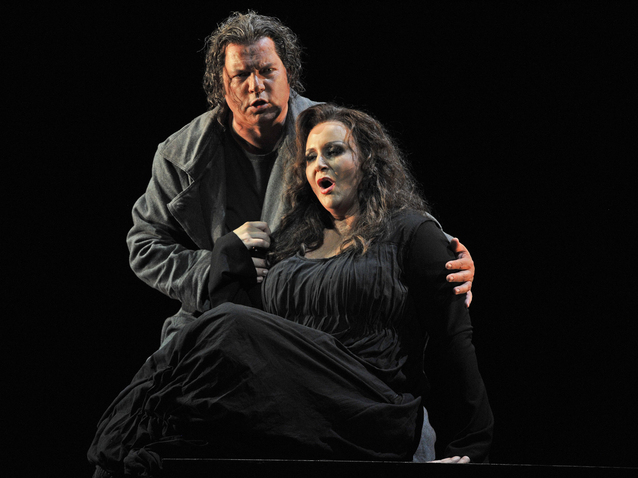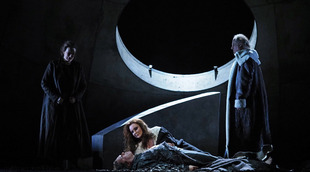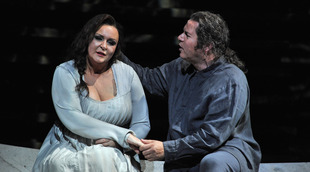 © (c) Antoni Bofill
© (c) Antoni Bofill
Excessive in every material and conceptual aspect, hypertrophic, beyond the limits of anything reasonable, redundant in the text to desperation, with a minimal dramatic action that tests the ingenuity and patience of stage directors, with terrible vocal demands, inhumane for the protagonists. Exhausting for everyone, audience included, the Wagnerian Tristan und Isolde is in its overflow one of the most sublime and genius excesses created by Western culture.
Once again we have been put to the test and eventually enlightened by the divine magic of this absolute piece that tells us about absolute love. We will surely remember this Tristan und Isolde for years to come, both for the kindness of the interpretation as well as the beauty and suitability of the production.

Tristan und Isolde (c) Antoni Bofill / Liceu

Tristan und Isolde (c) Antoni Bofill / Liceu
Iréne Theorin, loved at the theatre for her Brünnhilde in past seasons, was a powerful yet sweet Isolde, rounding the phrasing and defining the melody well amidst the instrumental storm. The Swedish soprano didn’t give out throughout the most exhausting role of the repertoire and even had strength left for a gentle decrescendo in the high register for a moving final Liebestod.
Stefan Vinke – who had offered a convincing Siegfried next to Theorin in the recent past – might not be a prodigy of subtlety and his singing can be sometimes feral and hard, but facing an incredibly tough role, was capable of administering himself with intelligence in the second act in order to be able to overcome the terrible vocal challenge of the third act with full sufficiency.
Marke, Kurwenal and Brängane, three “secondary” roles, which in any other opera would be considered “main” characters for their required vocal level, were defended by three top singers who contributed to the great success of the performance. Albert Dohmen’s Marke King was touching. In his long intervention in the third act, his voice sounded full, rounded and confident, and he filled with serene humanity the words of forgiveness to the lovers couple. Sarah Connolly was a high level Brangäne, always confident and dominating perfectly the nuances of the role of the devoted maid who, for pity, disobeys the orders of her lady triggering the drama.
It seems almost impossible that a bass-baritone could have “too much” voice to sing Wagner, but this is what happened at points with Greer Grimsley’s Kurwenal. So much was his sufficiency and so generous and unconditional his commitment to the character of the loyal friend, that at points he sounded almost strident and excessive in his intervention in the third act. Good Francisco Vas in Melot as well as all the other characters and the choir in their short intervention.
In an opera that lasts for over four hours it is almost impossible for the orchestral sound to be immaculate throughout. However, the level of the orchestra’s performance was very good and the musical direction of Josep Pons, a conductor who increasingly outstands in the Germanic repertoire, was appropriate, balanced and nuanced. At the end, the applause for the orchestra and its principal conductor were long and unanimous, and this – the audience appreciating their orchestra – is the best that can happen to an opera theatre.
The production, coming from the Opéra de Lyon, where it was premiered in 2011, was signed by stage director Alex Ollé (La fura dels Baus), Alfons Flores as scenographer, Urs Schönebaum at the fitting lighting, Franc Aleu at the creation of the video and Josep Abril at the sober costumes.
Ollé, very appropriately transcends the anecdote and goes straight to the symbolism of Tristan und Isolde. He doesn’t try to enrich a virtually inexistent scenic action and focuses instead on the psychological evolution of the characters in their inner journey, a journey guided by music. This idea, a difficult one to capture effectively on a stage was often achieved in this production. The scenography contributes to this very efficiently with its overwhelming and impressive spectacular coldness. An immense semi sphere is the moon in the first act, King Marke’s castle in the second in a concave disposition and finally, turned over again, in the third act it becomes both Tristan’s castle as well as a slab that oppresses and crushes him. At all times the semi sphere also acts as a screen where images that remind us of the inner journey of the characters are projected. All in all, it creates a whole of touching beauty that will remain for a long time in the memory.
Xavier Pujol
Tristan und Isolde by Richard Wagner. Stefan Vinke, tenor. Albert Dohmen, bass-baritone. Iréne Theorin, soprano. Greer Grimsley, bass-baritone. Francisco Vas, tenor. Sarah Connolly, mezzosoprano. Jorge Rodríguez Norton, tenor. Germán Olvera, baritone. Orchestra of Gran Teatre del Liceu. Choir of Gran Teatre del Liceu. Josep Pons, conductor. Alex Ollé (La Fura dels Baus), stage director. Alfons Flores, scenography. Urs Schönebaum, lighting. Franc Aleu, video. Production by Opéra de Lyon. Barcelona, 28th November 2017.
the 02 of December, 2017 | Print
Comments